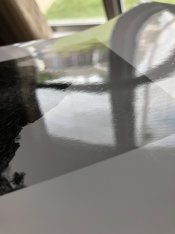So I’ve done the air dried glossy fiber print thing for years. I love the look. But my time is much more limited now and I’ve been taking a lot of 35mm pictures of my 3 year old and loving it. I recently had an evening to go into the darkroom and make a few prints on the new Ilford MGRC glossy paper and it is beautiful. A huge improvement over RC MGIV IMO. Anyway, I never really printed on glossy RC before (just contact sheets) I always used pearl but for the shots of my daughter they looked great on glossy.
So that got me thinking of how to achieve that look on FB. In my day job Im a framer and I see many older small single weight FB prints that were ferrotyped and they are beautiful! So that brings in the questions.
Can modern DW fiber papers be successfully ferrotyped? I’m going to assume that answer is yes. I wish I could still get my hands on some SW paper but there is none RIP.
Do I need a hardener in the fixer? I use Hypam. I can add a hardener to Hypam but never have and Ilford no longer makes one.
Can any old one of those heated canvas film drying drums be used as long as the plate is clean? https://www.ebay.com/itm/Premier-Professional-Photo-Print-Dryer-Model-TC-110/324185557312?_trkparms=aid%3D111001%26algo%3DREC.SEED%26ao%3D1%26asc%3D20160908105057%26meid%3Dd700614aa57c49de97ff89487cb677a3%26pid%3D100675%26rk%3D1%26rkt%3D15%26mehot%3Dnone%26sd%3D324185557312%26itm%3D324185557312%26pmt%3D0%26noa%3D1%26pg%3D2380057%26brand%3DPremier&_trksid=p2380057.c100675.m4236&_trkparms=pageci%3Adfc00982-b191-11ea-8178-facfa7a83ed8%7Cparentrq%3Ac8b2e60c1720a0f2bc14b23ffff93665%7Ciid%3A1
this is one I found on eBay. Would I need a separate plate for the ferrotyping or just do it right on the dryer?
Or lastly, Should I just forget that I ever asked these questions and continue using RC paper? From some of the research I’ve done here I’m sure some of you will suggest this. Haha!
I guess I’m looking for the longevity, feel and charm of FB paper with the gloss and of ferrotyping.
Thanks guys!! Sorry for such a long post.
So that got me thinking of how to achieve that look on FB. In my day job Im a framer and I see many older small single weight FB prints that were ferrotyped and they are beautiful! So that brings in the questions.
Can modern DW fiber papers be successfully ferrotyped? I’m going to assume that answer is yes. I wish I could still get my hands on some SW paper but there is none RIP.
Do I need a hardener in the fixer? I use Hypam. I can add a hardener to Hypam but never have and Ilford no longer makes one.
Can any old one of those heated canvas film drying drums be used as long as the plate is clean? https://www.ebay.com/itm/Premier-Professional-Photo-Print-Dryer-Model-TC-110/324185557312?_trkparms=aid%3D111001%26algo%3DREC.SEED%26ao%3D1%26asc%3D20160908105057%26meid%3Dd700614aa57c49de97ff89487cb677a3%26pid%3D100675%26rk%3D1%26rkt%3D15%26mehot%3Dnone%26sd%3D324185557312%26itm%3D324185557312%26pmt%3D0%26noa%3D1%26pg%3D2380057%26brand%3DPremier&_trksid=p2380057.c100675.m4236&_trkparms=pageci%3Adfc00982-b191-11ea-8178-facfa7a83ed8%7Cparentrq%3Ac8b2e60c1720a0f2bc14b23ffff93665%7Ciid%3A1
this is one I found on eBay. Would I need a separate plate for the ferrotyping or just do it right on the dryer?
Or lastly, Should I just forget that I ever asked these questions and continue using RC paper? From some of the research I’ve done here I’m sure some of you will suggest this. Haha!
I guess I’m looking for the longevity, feel and charm of FB paper with the gloss and of ferrotyping.
Thanks guys!! Sorry for such a long post.



